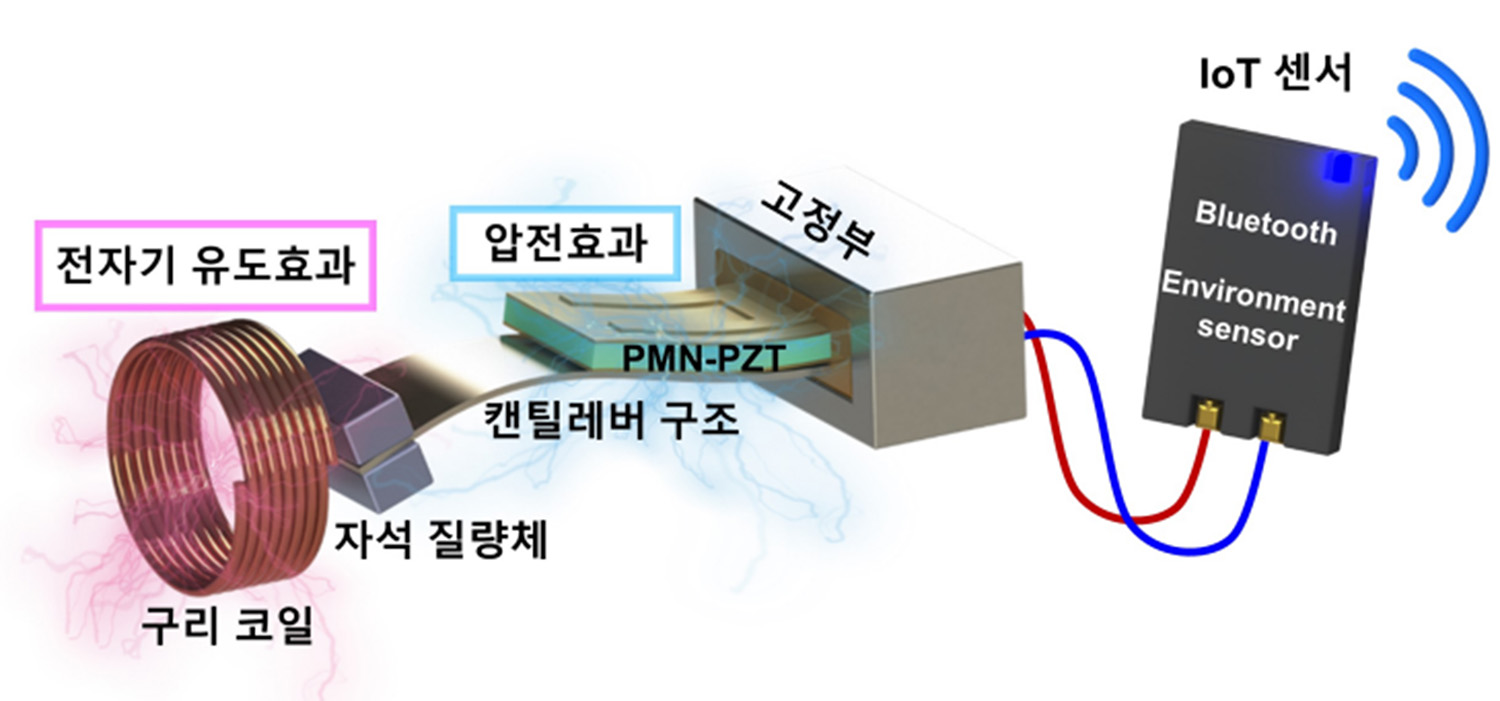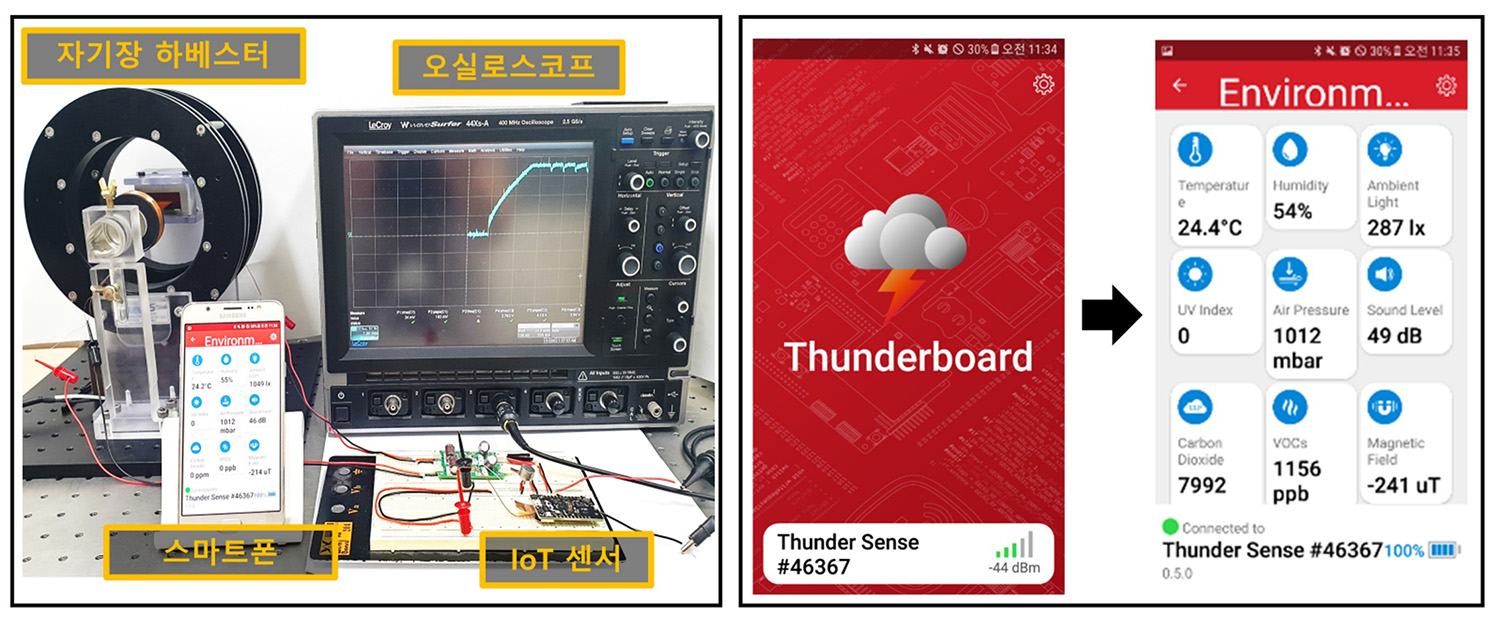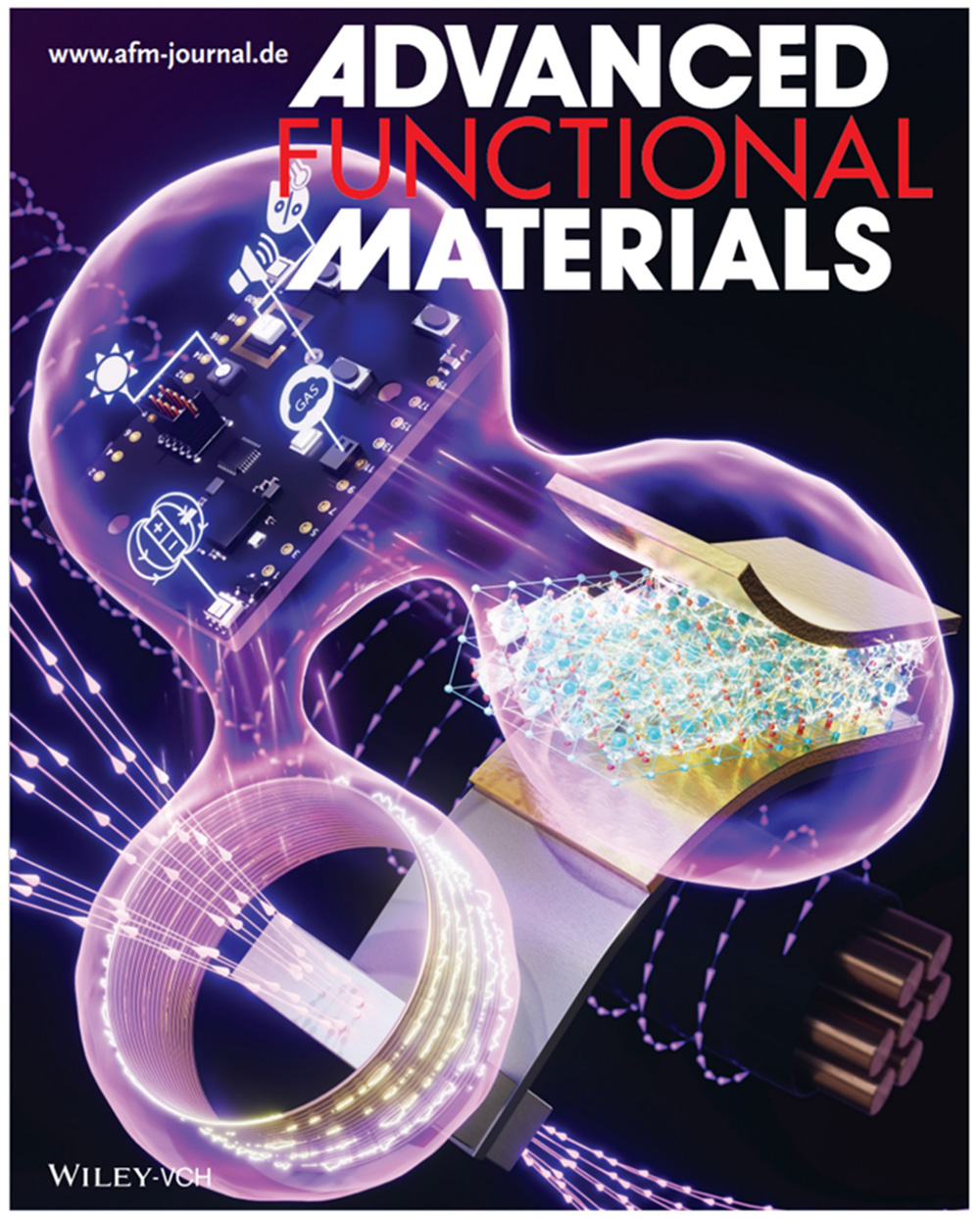커뮤니티
부경투데이
- 국립 부경대학교의 다양한 모습과 소식을 접하시면 부경대학교가 한번 더 가까워집니다.
| Research | 미세자기장으로 전기 생산 신기술 개발(Development of a new technology that can produce electricity with a micro magnetic field) | |||
| 작성자 | 대외협력과 | 작성일 | 2022-09-01 |
| 조회수 | 1067 | ||
| Research | 미세자기장으로 전기 생산 신기술 개발(Development of a new technology that can produce electricity with a micro magnetic field) | |||||
 |
대외협력과 |  |
2022-09-01 |  |
1067 |
버려지는 미세자기장으로 IoT 센서 구동 연구 ‘주목’
- 부경대 황건태 교수팀 … 에너지 출력 10배 높여 IoT 센서 구동 성공

△ 하이브리드형 자기장 에너지 하베스팅 시스템 구성 이미지.
버려지는 미세자기장으로 사물인터넷(IoT) 센서를 구동할 수 있는 전기 에너지를 생산하는 신기술이 개발돼 주목받고 있다.
국립부경대학교(총장 장영수) 황건태 교수(재료공학전공) 연구팀은 한국재료연구원 장종문 박사팀, 한국해양대학교 이삼녕 교수팀, 영남대학교 류정호 교수팀과 함께 다기능 IoT 센서를 구동할 수 있는 현존 최고 출력의 ‘자기장 구동형 하이브리드 에너지 하베스팅 소자’를 개발했다고 9월 1일 밝혔다.
4차 산업의 핵심기술로 떠오른 IoT는 다기능 센서와 무선통신 기능을 결합해 국가기반 시설의 무인감시, 조기경보 등 사회와 산업 전반에 활용될 수 있지만, IoT 센서에 전기 에너지를 원활하게 공급하는 것이 관건이다.
수많은 IoT 센서의 배터리를 일일이 교체하는 것은 비효율적이고, 사람의 접근이 어려운 곳에 설치된 IoT 센서는 주기적으로 배터리를 교체하기도 어렵기 때문.
이 같은 IoT 센서의 에너지원으로 활용하기 위해 우리 주위 어디에나 있는 전력선에서 필연적으로 발생하는 미세전기장을 수집해 에너지로 변환하는 자기장 에너지 하베스팅은 신재생 에너지 기술로 최근까지 활발한 연구가 진행되고 있다.
지금까지 개발된 자기장 에너지 하베스팅 기술은 에너지 발전 출력이 수 밀리와트(mW) 수준으로 매우 낮아 수십 mW를 소모하는 다기능 IoT 센서의 실시간 구동은 불가능한 문제점이 있었다.
부경대 황건태 교수팀이 이번에 개발한 하이브리드 자기장 에너지 하베스팅 소자는 기존보다 약 10배 높은 최대 60 mW의 에너지 출력을 달성했다. 연구팀은 이 소자를 적용해 습도, 온도, 자외선, 광량, 유기화합물, 이산화탄소, 압력, 소음, 자기장을 실시간으로 감지하는 다기능 IoT 센서의 연속 구동에도 성공했다.
연구팀은 세계에서 처음으로 압전효과와 전자기유도 효과를 동시에 적용하는 하이브리드 방식을 적용하는 한편, 새로운 기계적 공진모드를 발견해 하이브리드 자기장 에너지 하베스팅 소자에 도입했고, 압전효과 발생을 위해 사용된 Pb(Mg1/3Nb2/3)O3-Pb(Zr,Ti)O3(PMN-PZT) 물질의 산소공공 농도를 조절해 에너지 발전 출력을 비약적으로 높이는 데 성공했다.
이번 연구는 한국연구재단과 한국재료연구원 등의 지원으로 이루어졌으며, 연구 결과는 재료공학 분야의 세계적인 학술지 <Advanced Functional Materials> (IF: 19.9)에 최근 표지논문으로 게재됐다. <부경투데이>

△ 하이브리드 자기장 에너지 하베스팅을 이용한 다기능 IoT 센서 구동(좌) 및 다기능 IoT 센싱 항목(우)

△ 논문 표지 이미지.
Academia pays attention to research related to driving IoT sensors with discarded micromagnetic fields
- Prof. Hwang Gun-Tae's team at PKNU ... succeeded in driving IoT sensors by increasing energy output by 10 times
A new technology that produces electric energy that can drive Internet of Things (IoT) sensors using a discarded micro-magnetic field is drawing attention from academia.
Professor Hwang Gun-Tae (major of materials engineering) research team from Pukyong National University (President Jang Young-Soo) announced on September 1 that in collaboration with dr. Jang Jong-Moon's team at the Korea institute of materials science, professor Lee Sam-Nyeong's team from Korea maritime and ocean university, and professor Ryu Jeong-Ho's team from Yeungnam university, they have developed a 'magnetic field-driven hybrid energy harvesting device' with the highest output that can drive multi-functional IoT sensors.
IoT, which has emerged as the core technology of the 4th industry, combines multi-function sensors and wireless communication functions, and can be utilized in society and industries, such as unmanned monitoring and early warning of national infrastructure. However, it is more important to ensure that electric energy can be smoothly supplied to the IoT sensor.
It is inefficient to replace the batteries of many IoT sensors one by one, and it is difficult to periodically replace the batteries of IoT sensors installed in inaccessible places.
In order to use the IoT sensor as an energy source, the magnetic field energy harvesting system, which collects micro-electric fields that are inevitably generated from power lines everywhere around us and converts them into energy, is a new and renewable energy technology that has been actively studied until recently.
The previously developed magnetic field energy harvesting technology had a problem that real-time operation of multi-functional IoT sensors consuming tens of mW was impossible because the energy generation output was very low at the level of several milliwatts (mW).
The hybrid magnetic field energy harvesting device developed by Professor Hwang Gun-Tae's team at Pukyong National University succeeded in outputting energy of up to 60 mW, which is about 10 times higher than that of the previous one. This research team succeeded in continuously driving a multifunctional IoT sensor that detects humidity, temperature, ultraviolet rays, light quantity, organic compounds, carbon dioxide, pressure, noise, and magnetic field in real time by applying this device.
The research team discovered a new mechanical resonance mode while applying a hybrid method that simultaneously applies the piezoelectric effect and electromagnetic induction effect for the first time in the world. They introduced the new technology they discovered into a hybrid magnetic field energy harvesting device, and succeeded in dramatically increasing the energy generation output by controlling the oxygen vacancy concentration of Pb materials (Mg1/3Nb2/3) O3-Pb (Zr, Ti) O3(PMN-PZT) used to generate the piezo-electric effect.
The study was supported by the National research foundation and the Korea institute of materials science, and the results of this study were recently published as a cover paper in <Advanced Functional Materials> (IF: 19.9), a world-renowned academic journal in the field of materials engineering. <Pukyong Today>